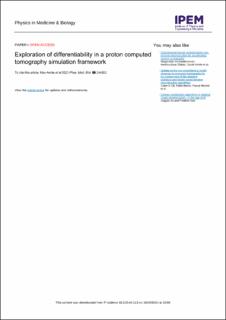| dc.contributor.author | Aehle, Max | |
| dc.contributor.author | Alme, Johan | |
| dc.contributor.author | Gábor Barnaföldi, Gergely | |
| dc.contributor.author | Blühdorn, Johannes | |
| dc.contributor.author | Bodova, Tea | |
| dc.contributor.author | Borshchov, Vyacheslav | |
| dc.contributor.author | van den Brink, Anthony | |
| dc.contributor.author | Eikeland, Viljar Nilsen | |
| dc.contributor.author | Feofilov, Gregory | |
| dc.contributor.author | Garth, Christoph | |
| dc.contributor.author | Gauger, Nicolas R | |
| dc.contributor.author | Grøttvik, Ola Slettevoll | |
| dc.contributor.author | Helstrup, Håvard | |
| dc.contributor.author | Igolkin, Sergey | |
| dc.contributor.author | Keidel, Ralf | |
| dc.contributor.author | Kobdaj, Chinorat | |
| dc.contributor.author | Kortus, Tobias | |
| dc.contributor.author | Kusch, Lisa | |
| dc.contributor.author | Leonhardt, Viktor | |
| dc.contributor.author | Mehendale, Shruti Vineet | |
| dc.contributor.author | Ningappa Mulawade, Raju | |
| dc.contributor.author | Odland, Odd Harald | |
| dc.contributor.author | O'Neill, George | |
| dc.contributor.author | Papp, Gábor | |
| dc.contributor.author | Peitzmann, Thomas | |
| dc.contributor.author | Pettersen, Helge Egil Seime | |
| dc.contributor.author | Piersimoni, Pierluigi | |
| dc.contributor.author | Pochampalli, Rohit | |
| dc.contributor.author | Protsenko, Maksym | |
| dc.contributor.author | Rauch, Max Philip | |
| dc.contributor.author | Rehman, Attiq Ur | |
| dc.contributor.author | Richter, Matthias | |
| dc.contributor.author | Röhrich, Dieter Rudolf Christian | |
| dc.contributor.author | Sagebaum, Max | |
| dc.contributor.author | Santana, Joshua | |
| dc.contributor.author | Schilling, Alexander | |
| dc.contributor.author | Seco, Joao | |
| dc.contributor.author | Songmoolnak, Arnon | |
| dc.contributor.author | Sudár, Ákos | |
| dc.contributor.author | Tambave, Ganesh Jagannath | |
| dc.contributor.author | Tymchuk, Ihor | |
| dc.contributor.author | Ullaland, Kjetil | |
| dc.contributor.author | Varga-Kofarago, Monika | |
| dc.contributor.author | Volz, Lennart | |
| dc.contributor.author | Wagner, Boris | |
| dc.contributor.author | Wendzel, Steffen | |
| dc.contributor.author | Wiebel, Alexander | |
| dc.contributor.author | Xiao, Renzheng | |
| dc.contributor.author | Yang, Shiming | |
| dc.contributor.author | Zillien, Sebastian | |
| dc.date.accessioned | 2024-02-21T07:06:18Z | |
| dc.date.available | 2024-02-21T07:06:18Z | |
| dc.date.created | 2024-01-05T14:44:27Z | |
| dc.date.issued | 2023 | |
| dc.identifier.citation | Physics in Medicine and Biology. 2023, 68 (24), . | en_US |
| dc.identifier.issn | 0031-9155 | |
| dc.identifier.uri | https://hdl.handle.net/11250/3118816 | |
| dc.description.abstract | Objective. Gradient-based optimization using algorithmic derivatives can be a useful technique to improve engineering designs with respect to a computer-implemented objective function. Likewise, uncertainty quantification through computer simulations can be carried out by means of derivatives of the computer simulation. However, the effectiveness of these techniques depends on how 'well-linearizable' the software is. In this study, we assess how promising derivative information of a typical proton computed tomography (pCT) scan computer simulation is for the aforementioned applications. Approach. This study is mainly based on numerical experiments, in which we repeatedly evaluate three representative computational steps with perturbed input values. We support our observations with a review of the algorithmic steps and arithmetic operations performed by the software, using debugging techniques. Main results. The model-based iterative reconstruction (MBIR) subprocedure (at the end of the software pipeline) and the Monte Carlo (MC) simulation (at the beginning) were piecewise differentiable. However, the observed high density and magnitude of jumps was likely to preclude most meaningful uses of the derivatives. Jumps in the MBIR function arose from the discrete computation of the set of voxels intersected by a proton path, and could be reduced in magnitude by a 'fuzzy voxels' approach. The investigated jumps in the MC function arose from local changes in the control flow that affected the amount of consumed random numbers. The tracking algorithm solves an inherently non-differentiable problem. Significance. Besides the technical challenges of merely applying AD to existing software projects, the MC and MBIR codes must be adapted to compute smoother functions. For the MBIR code, we presented one possible approach for this while for the MC code, this will be subject to further research. For the tracking subprocedure, further research on surrogate models is necessary. | en_US |
| dc.language.iso | eng | en_US |
| dc.publisher | IOP Publishing | en_US |
| dc.rights | Navngivelse 4.0 Internasjonal | * |
| dc.rights.uri | http://creativecommons.org/licenses/by/4.0/deed.no | * |
| dc.title | Exploration of differentiability in a proton computed tomography simulation framework | en_US |
| dc.type | Peer reviewed | en_US |
| dc.type | Journal article | en_US |
| dc.description.version | publishedVersion | en_US |
| dc.rights.holder | © 2023 The Author(s) | en_US |
| dc.source.pagenumber | 18 | en_US |
| dc.source.volume | 68 | en_US |
| dc.source.journal | Physics in Medicine and Biology | en_US |
| dc.source.issue | 24 | en_US |
| dc.identifier.doi | 10.1088/1361-6560/ad0bdd | |
| dc.identifier.cristin | 2221527 | |
| dc.relation.project | Norges forskningsråd: 250858 | en_US |
| dc.relation.project | Trond Mohn stiftelse: BFS2017TMT07 | en_US |
| dc.source.articlenumber | 244002 | en_US |
| cristin.ispublished | true | |
| cristin.fulltext | original | |
| cristin.qualitycode | 1 | |

